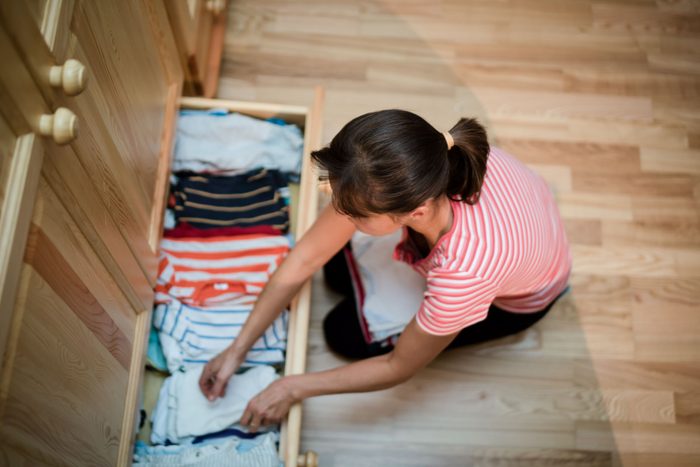
Small projects, big results
Who has the energy for organizing tasks that take hours? No one, not even if you suddenly have more time on your hands these days. Plus, when you feel overwhelmed by the magnitude of the project, there’s a good chance you’ll keep putting it off. That’s why these 30 mini makeovers that take 30 minutes or less are such a good idea. Not only will you actually tackle them since they’re manageable, but you’ll also feel really proud of yourself when you see the instant results. So, what are you waiting for? Get ready, get set, and start that timer! For more ideas, check out these 50 organizing tips you’ll wish you knew all along.
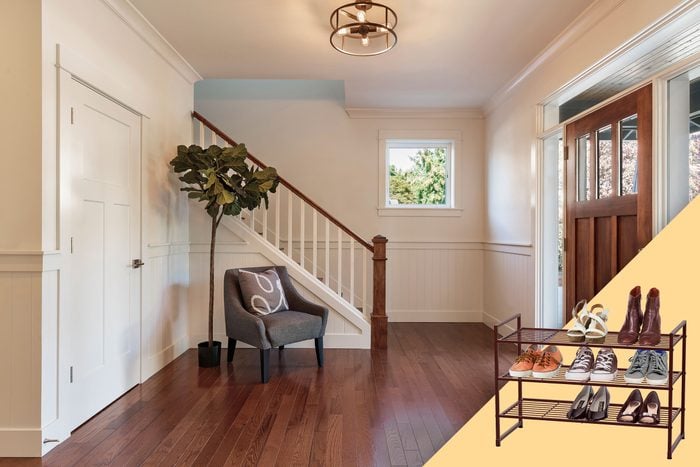
Entryway
Your home’s entryway is often a mess of mixed categories, accumulating everything from outerwear and shoes to keys and mail. Now, more than ever, it’s time to organize this disaster area—not just for your sanity but because it can also help keep germs at bay. First up: your shoes. You shouldn’t be wearing shoes in your house, since they can track in viruses, bacteria, and toxins. To decrease that temptation, have a spot for them right near the door. A sturdy three-tier shelf, like this one by Simple Houseware, will do the trick. Once that task is done, tidy the rest of the space by designating a spot for everything you store there. Use hooks for house keys, a basket for your wallet, and another organizer for incoming mail. Once you know where everything needs to go, it’s easy to keep the area clutter-free.
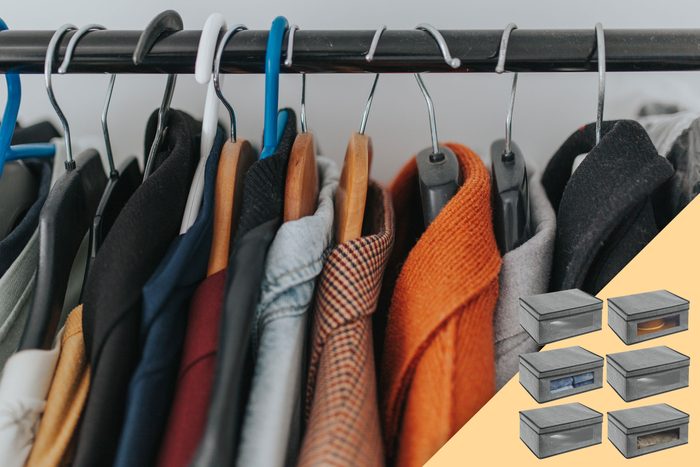
Coat closet
Your coat closet is one of those places where you stash random things when you don’t want to deal with them. Take 30 minutes and deal with them now. A neatly arranged closet will allow you to see what you have so you can use what you own. As you clear everything out, group items into categories, like outerwear and seasonal. Then, make a pile of things to be given away. (Just be sure to check the pockets of jackets first.) For newly cleared shelves, add a set of organizing boxes. Pro tip: Ones with clear windows are best since they allow you to see what’s inside. By the way, these are the 15 things you’re doing to your closet that professional organizers wouldn’t.
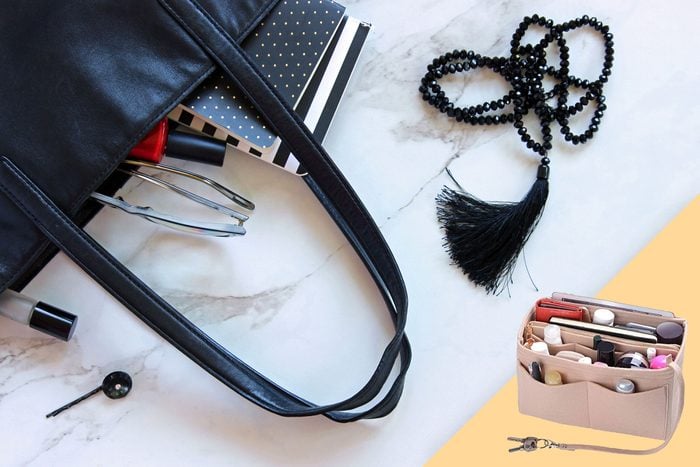
Everyday bag
Chances are, your everyday bag is getting a lot less use these days. Time to dump it and find any forgotten items! Next, toss all the trash, including wrappers and crumpled tissues, and sort through receipts, filing only what you need to keep and recycling the rest. But instead of simply tossing in the essentials, place them in a bag organizer with dedicated sections. This makes everything easily accessible, so you don’t have to dig around your bag for that one thing you can never seem to find. Plus, it makes swapping bags super easy—all you have to do is transfer the insert and you have everything you need!

Living room
It’s the space where people congregate the most, and now it’s probably being used for multiple purposes, like a home office or even a workout space. The key to keeping it uncluttered and functional? Stylish storage options—lots of them. You should have a basket for remote controls, a container for catalogs and magazines, and bins to hold materials for an ongoing craft project, work-related tasks, or an exercise routine. Nesting baskets are a particularly good idea because when they’re not in use, they take up very little room. Once everything has a place to go, cleaning up at the end of the day is easy.
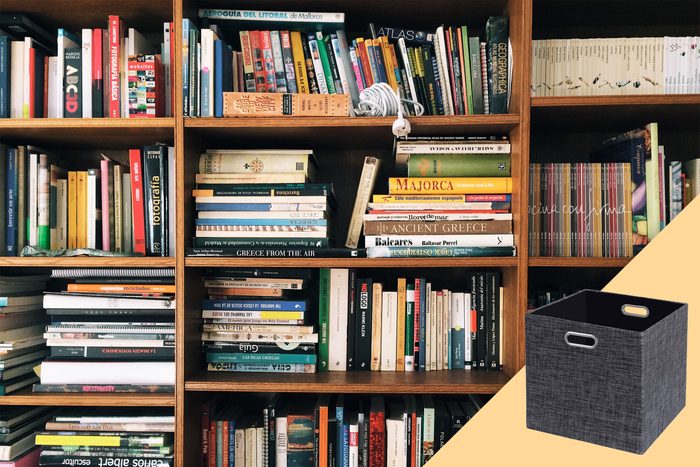
Bookcase
This one might be tough, but we know you can do it. Take stock of the titles you have sitting on the bookcase; there’s likely one or more that you can part with today. Keep an empty, reusable bag nearby to hold all the books you are willing to toss or pass on to someone else. Here are some questions to consider as you organize your book collection: Is it outdated, such as that travel guide from a few years ago? Or is the book easily available to you in another way, like a digital version? Letting go of even a few books means you’ll have space to add some baskets, which can add visual interest and hide unsightly items like video-game controllers and cords. Check out these 8 tricks interior design experts use to stylishly organize bookshelves.

Magazines and catalogs
A small stack of magazines and catalogs can quickly turn into a towering pile. Pare down the collection in just a few minutes by going through them one at a time, resisting the urge to shuffle them into a bunch of smaller piles. Instead, toss what you don’t want into the recycling bin. A good rule of thumb is to store no more than six months’ worth of your favorite titles. Use sturdy magazine organizers to keep the magazines standing upright and clearly labeled for easy reference. To prevent future pileups, consider going digital. Not only will it help you organize your space—but it will also help you save time, since you can easily search for what you need with a few taps of your keyboard instead of rifling through stacks of paper.
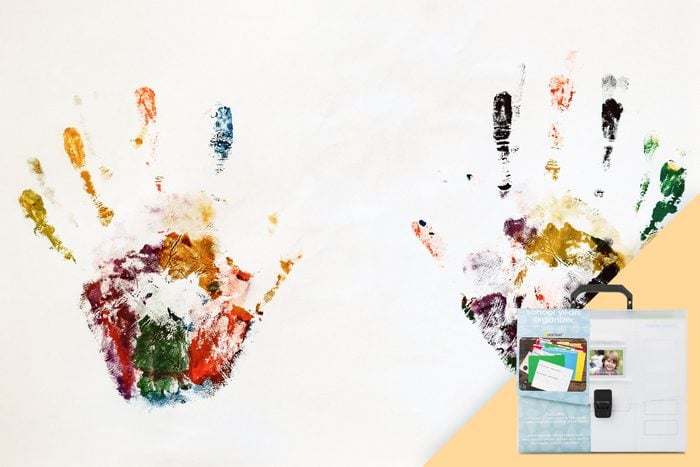
Keepsakes
Spend some of your indoor time safeguarding special memories. Gather irreplaceable children’s artwork and other paper-based keepsakes—and keep the best and toss the rest. Try to remember that if you keep everything, then none of it will be special. Protect special pieces by digitizing them, either with a scanner or by taking a photo (in good lighting) so that you can share it with friends or family. If you have years’ worth of children’s treasures and schoolwork to sort, try Pearhead’s School Years Organizer.
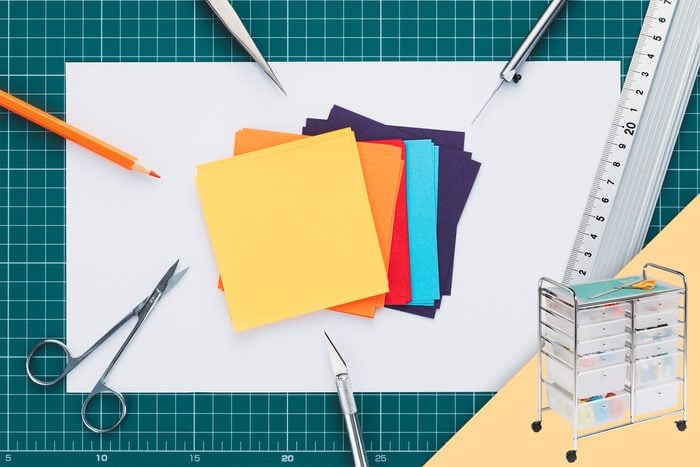
Arts and crafts supplies
Whether you have kids at home or you’re just the crafty type, that stash of craft supplies can get messy. The first thing that should go? Anything that’s broken, dried up, or dried out. Next, make it easy to find what you’re looking for when you have a burst of creativity by putting your supplies in containers and labeling them; for bonus points, add a photo as well as a written label. If you have the room, opt for a rolling storage cart, which lets you bring your supplies wherever you work, eliminating the temptation to leave your supplies all over the table without cleaning them up.
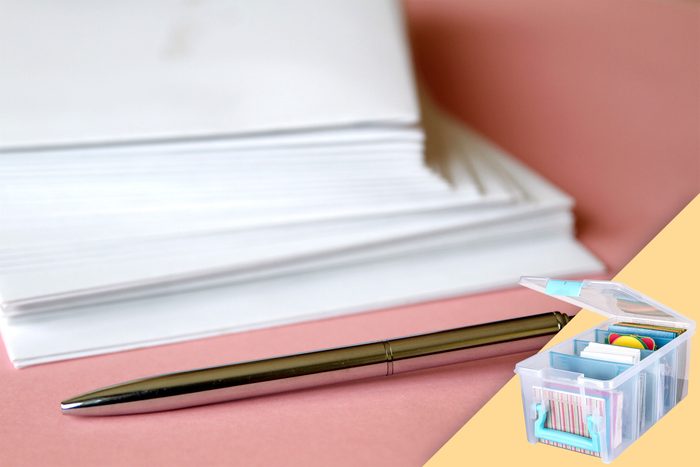
Stationery supplies
There’s probably more than you realize stuffed in your desk drawers. Do a quick inventory so you know what you have; you’ll avoid wasting money repurchasing something you already own and adding unnecessarily to the pile. If you have an overabundance of greeting cards, group them together and match each to the correct blank envelope. And store the supplies you’ll use over the next year in containers with removable dividers (which make them customizable). Now that your stationery is organized, you’re ready to write some notes. Here are 8 times etiquette dictates you should send a handwritten thank-you note.
Plastic Storage Case, Clear with Aqua Accents, 0″ product_price=”18.75″ product_category=”Home” product_retailer=”Amazon.com” content_rating=”” /]

Accessories
There are a few problems with accessories: It’s easy to accumulate them, and unless you have an organizer made specifically for them, they’re hard to organize. So, start with your belts, and toss the ones you never wear. Next, address the ties or scarves, keeping only the ones you like and find yourself wearing. (Be ruthless. If you haven’t worn it in years, that’s likely not going to change.) Store the ones that are specific to only one outfit on the hanger with that outfit. Keep others in your line of sight, and organize them on a hanging rack; after all, if you don’t see them, you won’t wear them.
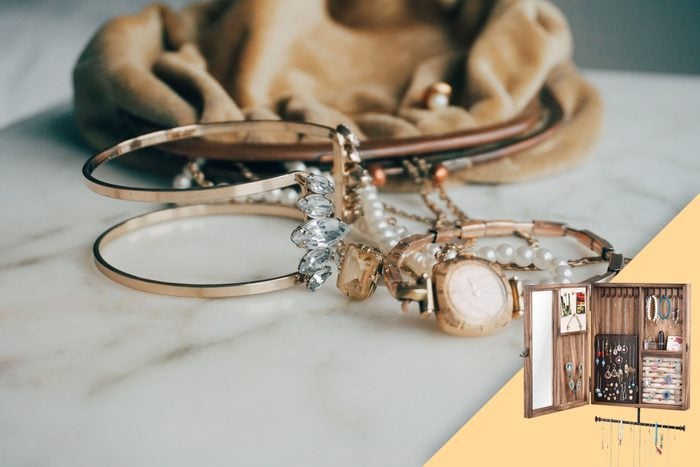
Jewelry
Chances are, your costume-jewelry collection needs a little organization. Between the statement necklaces, the stretch bracelets, and the dangling earrings, it can easily become a tangled mess. Sort the pieces, then group them by type and occasion. Set aside any you want to give away, and store the keepers. To keep your pieces tangle-free, try displaying them just like a retail store would—in a display case with hooks and holders. A wall-mounted organizer offers spots for stud earrings, watches, and more. Here are more tips for storing your jewelry and keeping it clutter-free.
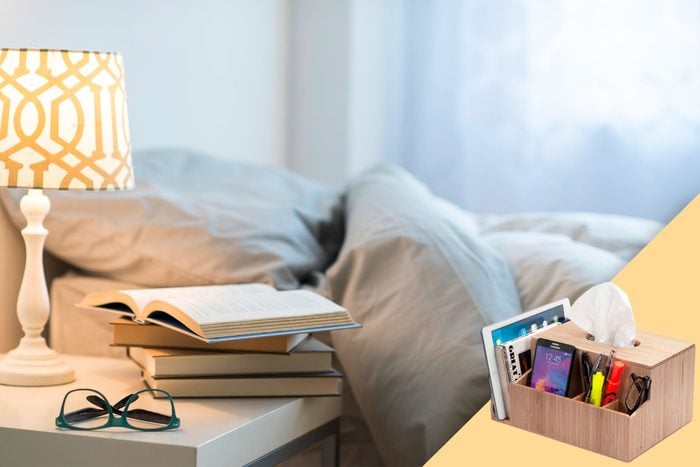
Bedside table
Create a more restful sleeping environment by clearing the clutter from your bedside table. That dusty pile of magazines, the ones you never read at bedtime anyway, can be relocated to the living room. Keep only what you use, like the one book you’re currently reading, a journal, and pen. Storing it all in an organizer—that has spots for tissues, your tablet, and reading glasses—keeps things tidy. You might also want to add something that helps you sleep better or that makes you happy, like a favorite framed picture, but keep it to a minimum.
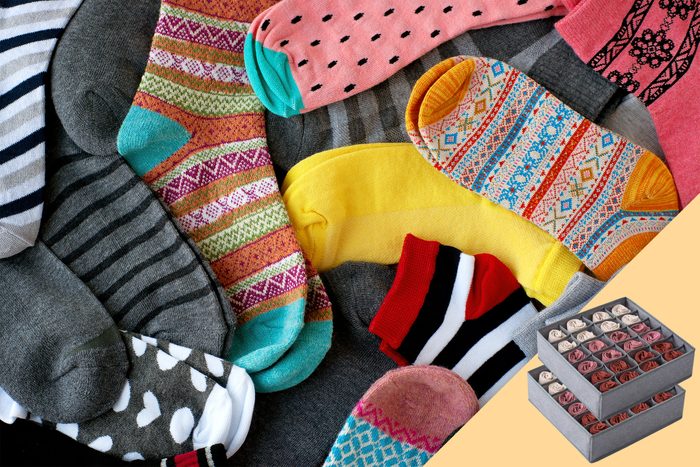
Sock drawer
Your overflowing sock drawer needs your attention. How do we know? Because that’s the case for the majority of us. Dump the drawer and match up the pairs. And whatever you do, don’t simply put back lone socks or socks you don’t like. That’s how you got into this mess in the first place. Mate-less socks can be used for cleaning or one of these other brilliant uses for old socks. Ones with holes can be sent to textile recycling. And the socks that you find uncomfortable, too tight, or too loose can be donated. For the ones you do keep, a collapsible drawer organizer gives you lots of slots for storage and also lets you know, at a glance, when you’re running low and probably need to do laundry.
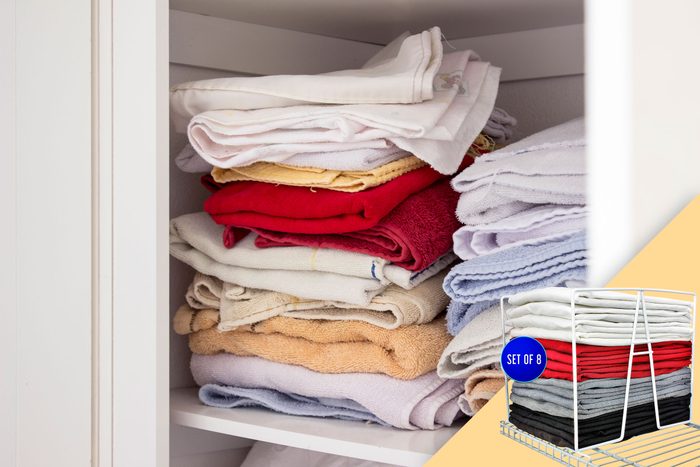
Linen closet
Do you even know how many sets of sheets and towels you own? If it’s hard to find the ones you need when you’re looking for them, then it’s time to trim down your linen collection. Empty the shelves, and sort everything—grouping like-size towels, putting washcloths with washcloths, and finding all the pieces of a sheet set. Fold and stack the keepers by usage, sliding dividers onto the shelves to prevent tall piles from tipping over. Send your least favorite or most threadbare sets to a local pet shelter to be used for bedding or baths. Check out these other things you didn’t know you could donate.
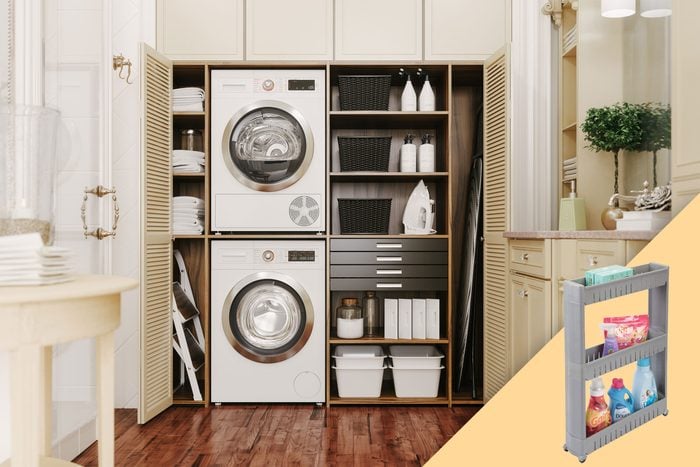
Laundry area
Just a few minutes is all it takes to lighten the load in your laundry area. Prioritize the half-empty bottles for use, then toss them once they’re empty. Discard spray bottles with broken triggers. Give extra supplies, cleaning solutions that don’t work as promised, or ones you don’t like to a pet shelter; volunteers have never-ending piles of laundry to wash. Return the collection of things found inside pockets to where they belong. And finally, straighten up the remaining supplies and store them on a slim sliding shelf, like this one from mDesign, which fits in the smallest of spaces.

Photos
Taking photos with your phone is easy. Deleting the ones you don’t want or need is not. You snap the photos and move on, forgetting the most important step: hitting the delete button! So, take a few minutes to scroll through the photos and resolve to delete as many as you can manage. Delete them for any little reason at all—bad lighting, blurry hands, or just too many of the same scene. Paring down to the best one means you’ve found the best image that tells the story, and that makes them easier to share, print, or organize into a book. You can also send stellar ones directly to a WiFi-enabled digital frame, letting you enjoy them instead of forgetting about them on your phone. One word of warning: Try not to get sidetracked; it’s easy to start reminiscing when you start this process.
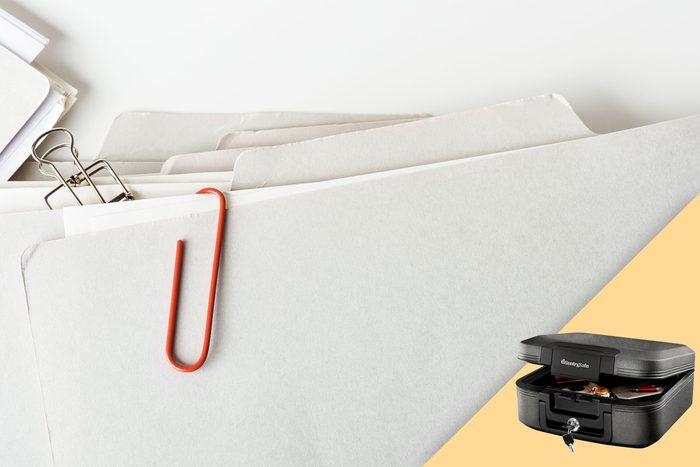
Vital records
We’re talking about the documents that can be difficult or expensive to replace if lost or stolen. Knowing where they are and that they are safe gives you peace of mind. Although you may have others, these ten types of documents are the ones you should pull together first: birth certificates, death certificates, marriage licenses and certificates, divorce decrees, court orders and other government-issued documents, your will and other estate-planning documents, deeds to show ownership of land, automobile and property titles, social security cards, and passports. Once you find them, store them in a fire- and water-resistant safe.
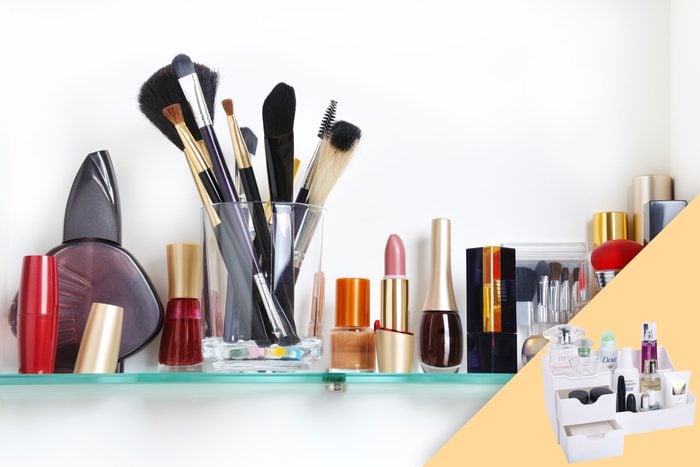
Toiletries
Pull everything out of your shower and vanity. See what’s still in good condition and usable, toss anything that’s gunky, and recycle the empty bottles. Do you have some products that you tried but didn’t like? No matter how much they cost, if you don’t use them, don’t keep them. Next, think about your morning and bedtime routines, and keep the products you use for each grouped together and stored in a vanity organizer with drawers. Place your favorite everyday products back in the shower, and you’re all set! Here are 10 things to get rid of in your bathroom right now.
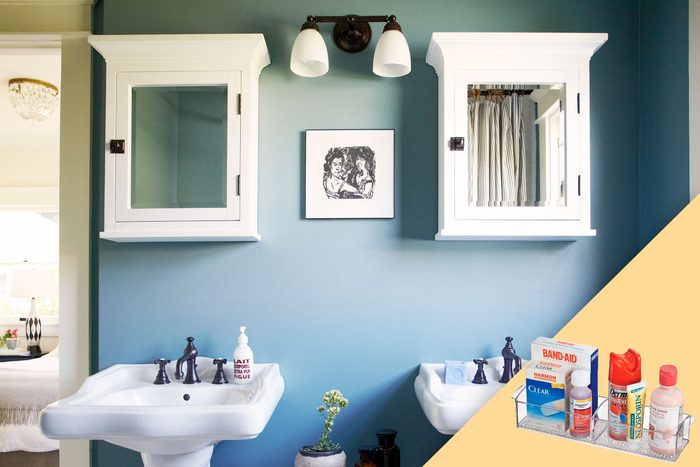
Medicine cabinet
It’s important to have the right stuff on hand in case you or a family member gets sick. By organizing the medicine cabinet, you’ll see what you have and what you don’t—and whether or not your must-have items have expired. First, group the medications and supplies into categories such as cold and flu, allergy, vitamins and supplements, prescriptions, dental, eye care, and bandages. As you group them, check the expiration dates and dispose of expired medications. Don’t forget to make a shopping list of anything you may need to replace. Once you have your items sorted into categories, use containers with labels to store them.
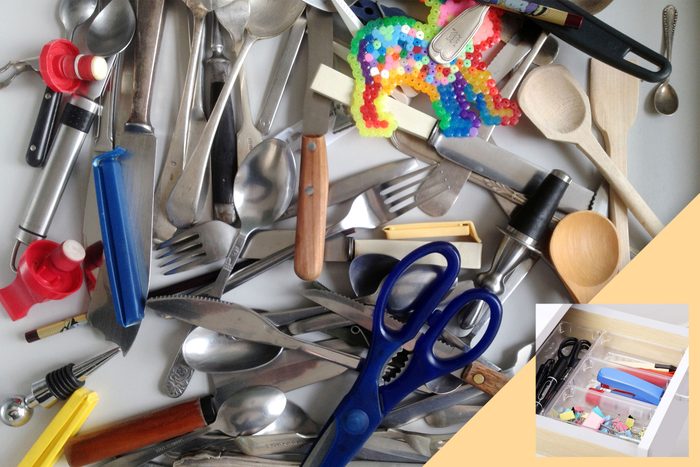
Junk drawer
We call them junk drawers, but they should actually be useful and not contain actual junk. The good news is that it’s easier than you think to organize one. First, dump out the contents of the drawer, and throw away any trash. Then sort the items that are left, deciding what stays and what goes. Search for things that are better stored elsewhere and move them to that room. (Yep, right now.) For the things that stay, organize them in a customizable drawer organizer, one that features many different-sized bins so you can get the exact fit in the space. It makes a huge difference. When you’re putting items to their rightful spots, make sure batteries aren’t among your stash.
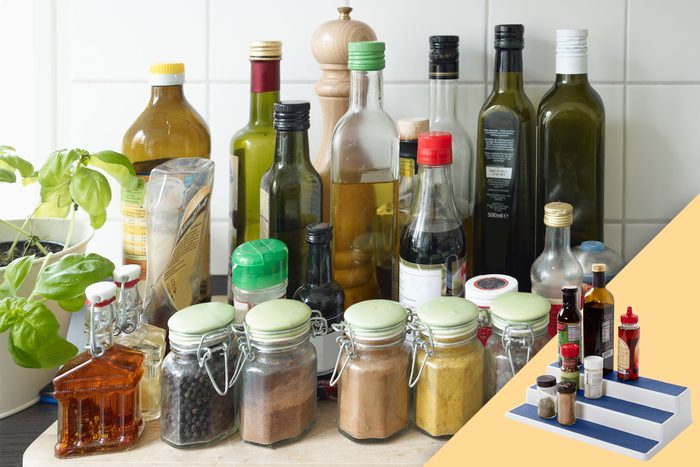
Spices
If you’ve ever reached for paprika but had trouble finding it (or anything else) in the disarray, your spice rack needs some TLC. Pull out all the spices, and as you do, check the expiration dates on the containers. Although most don’t spoil, it does lose its potency and won’t add any flavor to your dish. Return the ones you are keeping to the cabinet with the labels facing out. Adding a three-tier organizer allows you to fit more in the space, and everything will be clearly visible. Try storing it by frequency of use instead of alphabetically, so the ones you use most often will be upfront.
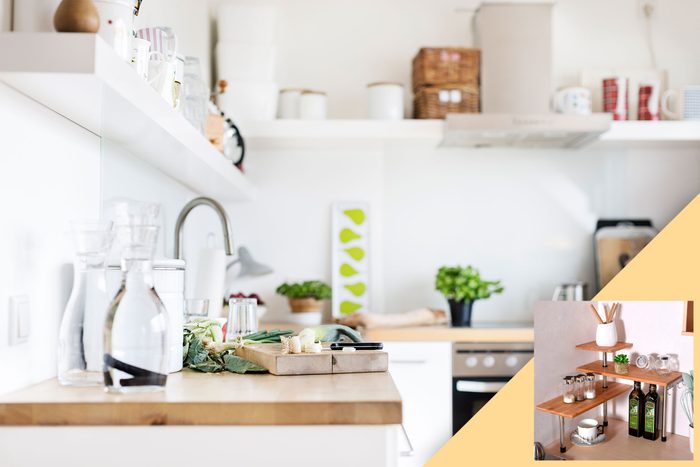
Kitchen countertops
Kitchen countertops are a common dumping ground for all sorts of stuff. Continually having to clear the countertop is a waste of your time—plus, some items create breeding grounds for germs. Declutter the space and then keep it tidy with a multi-tiered corner organizer, which gives you lots of storage space but takes up barely any room. You’ll have a spot for pocket change, rubber bands, and even a basket for mail, or alternately, often-used kitchen supplies. FYI, don’t store these 10 things on your kitchen countertop.
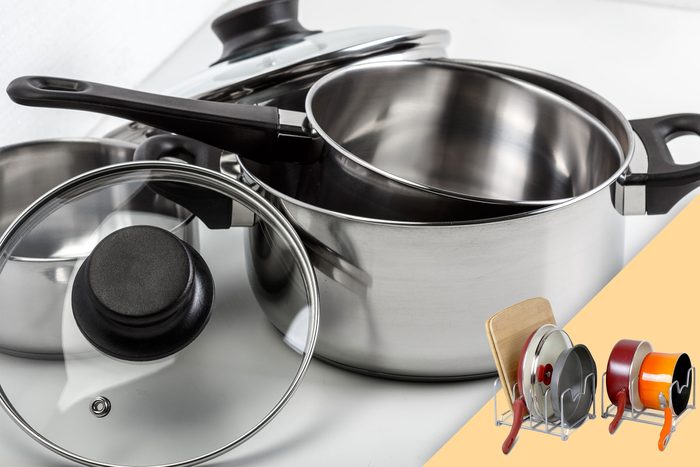
Pots and pans
It’s not your imagination: Your pots and pans are taking over your cabinet, making it impossible to find anything—or get it out without toppling over half of the things in there. But you don’t have to grin and bear it. First, match up lids to pots and inspect them for quality. Non-stick pans that are bubbling or peeling should be discarded. Then, put aside any that you don’t use, for any reason—whether it’s too heavy, too light, or burns food easily. Return the ones you like to the cabinet. Storing them in an organizing rack made specifically for them allows you to take one out quickly and easily.
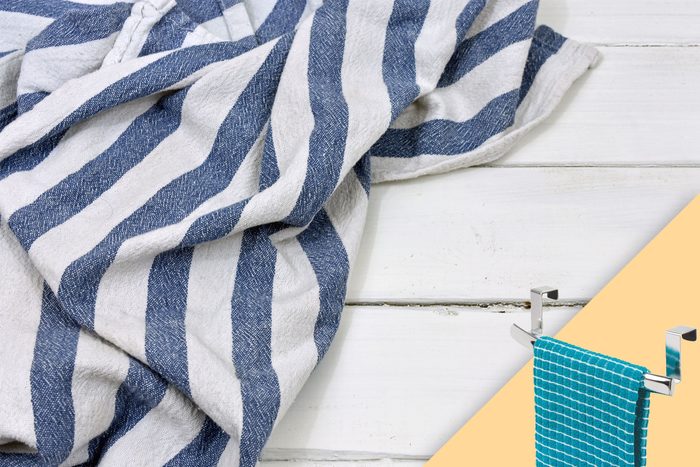
Dishtowels
If the dish-towel drawer won’t close, it’s time to declutter. Pull them all out and inspect them for quality. Ratty, torn, and threadbare towels can be used as cleaning rags or sent to textile recycling. Store the one or two towels currently in use over a cabinet towel bar, then rotate them with the now-easily-found fresh ones when they need a wash. In case you’ve ever wondered, here’s how often you should be washing your dish towels.
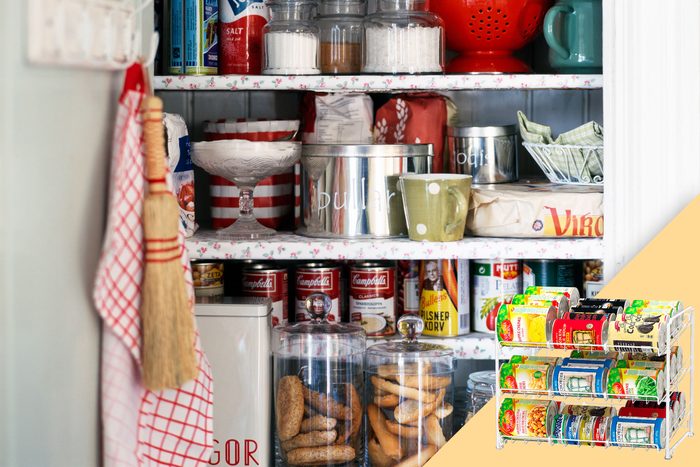
Pantry
Thirty minutes might not be enough time to take everything out of the pantry and start from scratch. But it is plenty of time to organize whatever’s gotten particularly chaotic. Where to start? First, remove anything still in space-stealing packaging. Then, arrange sections based on grocery-store aisles; this makes it easy to write a shopping list and shop in the order of how the store is set up. Add a can-rack organizer to save space and ensure you are rotating your cans, using the oldest first. Make sure to turn everything so that you can see the labels.
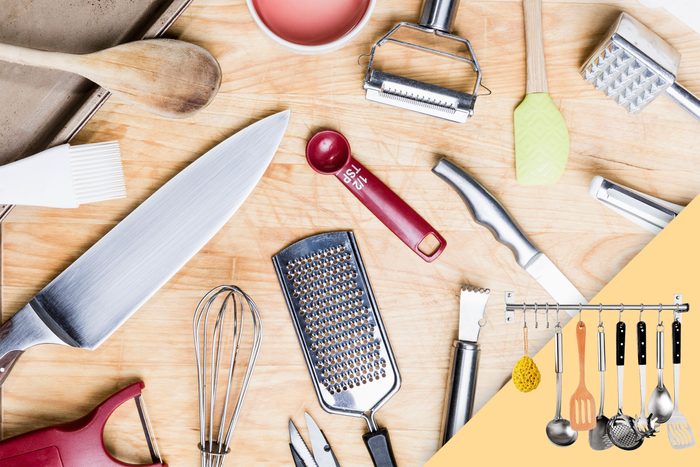
Utensils
Whether you store your kitchen utensils in a crock on the countertop or in a drawer, there must be a few you can part with. Toss any that are flimsy, melted, or warped. The idea is to pare down to the ones in great condition that you reach for daily. A wall-mounted S-hook rail can save space and free up much-needed drawer space, and it gives you easy access to what you need. If there are tools you want to keep but don’t use daily, relocate them to a less convenient spot. Now here’s what you need to know about placing utensils in the dishwasher: Should they go up or down?
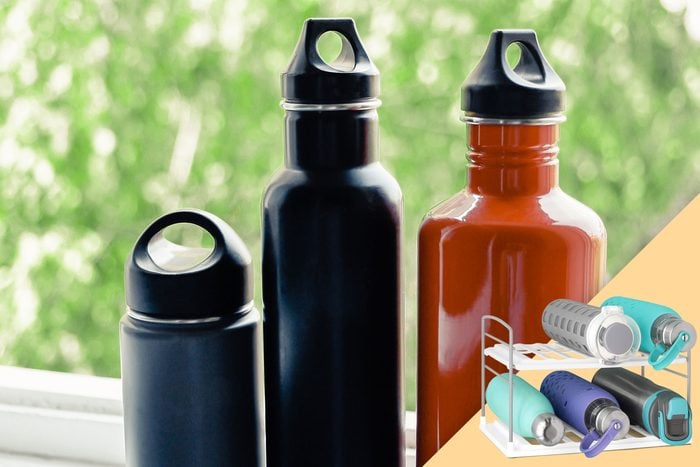
Water bottles and travel mugs
It is all too easy to collect enough water bottles and travel mugs to equip a small café. Remove them all and place a drink-bottle organizer inside the cabinet. This will give you a slot to store the keepers. It also gives you a limit as to how many you should hold onto. A good rule of thumb is two per family member. Toss any that leak or are missing a key component, like a lid. If you need to refresh your stash, consider these 10 smart water bottles that are worth the money.
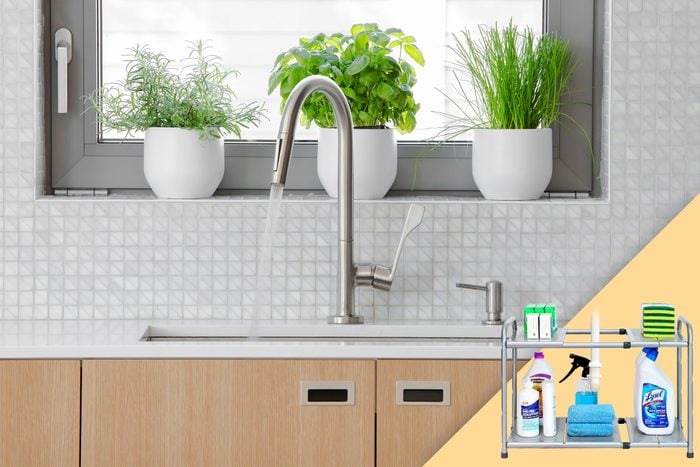
Under the kitchen sink
When was the last time you organized this spot? It may feel daunting, but it won’t take long and you can create a ton of extra storage space just by cleaning out the clutter. The first task is to pull everything out. Once you can easily see what you have, return only the items that you use. Toss anything that is broken, expired, or looks gross. Next, add customizable shelves that fit around the plumbing. Once you have proper shelving, it’s easier to keep the space tidy, since you won’t just toss everything into a dark hole.
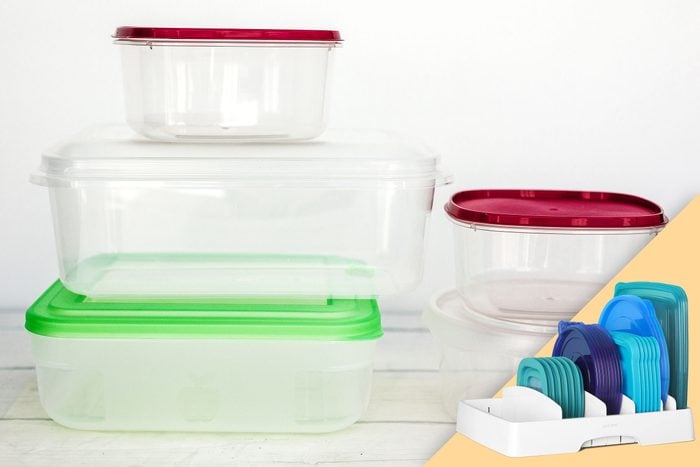
Food storage containers
Right now, we’re all cooking, prepping, and storing more food than usual—and for many of us, that’s highlighted some serious deficiencies in our storage spaces. One thing you can do quickly: Match food-storage containers and lids, tossing any that are cracked, warped, melted, or don’t seal properly. Then, get an organizer to keep them all together. Move the ones you rarely use to a less convenient spot, so they are out of the way.
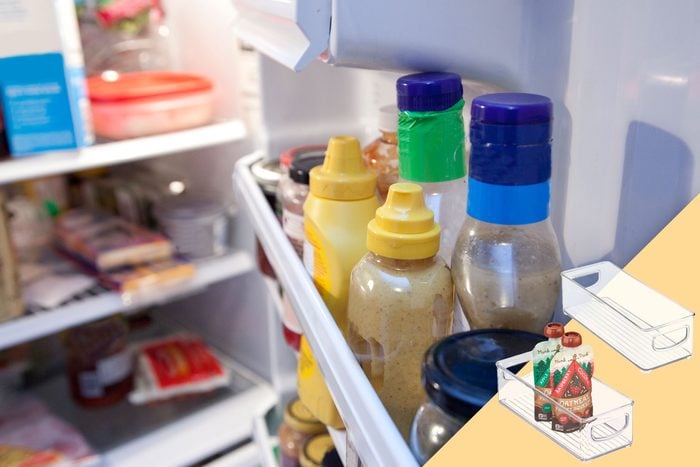
Condiments and marinades
There’s nothing more maddening than reaching for one of these items in the fridge and realizing you barely have any left. A little reorganizing can go a long way to ensure this doesn’t happen as you’re cooking or about to chow down. As you remove all the bottles, jars, and containers, check the expiration dates. Toss anything that is past its prime, anything that has changed color or consistency, and anything you don’t like enough to finish. Keep a running shopping list of things you are missing or need to replace. Then, group together similar flavors of marinades and sauces. Store them in easily washable plastic bins, so the next time one leaks, the mess will be contained and easy to rinse off.
